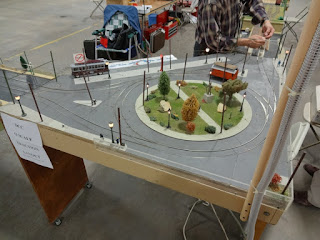When the model was received from Jim Osborn, a separate interior floor with the partitions for the lavatory and buffet was included with the model. Unfortunately a photo of the styrene model was not taken.
To give you an idea as to what the body shell might look like, this is a CA&E 700 series car body. The model is bare without handrails and other details. The roof has been primered plus the model has been mounted on trucks by me..
This body shell came with the steps. Most of the time the modeler has to add the steps The center line of the floor is marked on the underside. Depending upon the model the truck centers may be marked. If the model has a rounded anticlimber, the center of the radius is marked.
ELECTRICAL
The best place to start is with an electrical diagram of the model. These are the given constraints: 1) the model is a trailer although the prototype is a powered car, 2) there are trolley poles which can be used to pick-up electrical current although this model will receive track voltage from the lead car, 3) a Dallee adjustable power supply will be used to control the 1.5 v bulbs, and 4) besides interior lighting the model will have a pair of rear-end marker lamps plus the standard MET rear-end red lamp.
Some of the constraints require explanation. The model of the Florence needs a jack for the 12-18 v pigtail from the lead car to plug into. As an aside, any CA&E models which are to be run together need to have a method to buss the trolley current between them. Only the trolley pole on the lead car is to be up when multiple cars are run in a train.
Although the Dallee adjustable units are expensive 2 units are being install - 1 in 314 car and 1 in the Florence. One Dallee unit should be able to handle all the bulbs in both cars. The Florence may not always be trained with the 314. It's better if the Florence can be run with other models and still be able to have constant voltage lighting. Also, the Florence can be on a siding by itself and "plugged" into track voltage with the lights on for display purposes.
The rear-end markers will be PSC brass castings. The standard MET required rear-end red lamp will be scratch-built.
This is the electrical diagram for the Florence. Please excuse my rough drawing.
TRUCKS
The trucks are PSC Baldwin 7830 with NWSL wheels and Q-Car Co. CA&E 3rd rail beams were glued on using ACC.
DETAILS
Now is the time to add details to the model. The MET required rear-end red lamp was a special lamp to be displayed on the rear on trains on the Garfield Park Division of the MET from sun set to sun rise. Since the AE&C and later the CA&E when operating on the "L" operated by the same rules as the MET. the AE&C had to have the same type of red lamp.
Today these red lamps are extremely rare. To get an idea how one of these lamp looked like take a look at the photo of a MET rear-end red lamp on page 79 in The Shore Line Interurban Historical Society "Dispatch Number 1, Cooperation Moves the Public". The red lens is a big as the width of the lamp housing. The lens is also bigger than the lens on a marker lamp.
This is another photo of the same lamp. Bruce Moffat has had the lamp mounted for furniture top use. Notice the "D" rings on the bottom of the lamp base. These make the lamp a CRT rear-end red lamp. The CRT had this type of lamp as well as the CA&E. If you read "Cooperation Moves the Public" you will under stand the reason for the lamp.
The CA&E lamps were able to mount on the rear door of the train in the same location and style as the headlight on the front of the train. The CRT didn't always have a flat panel door on to which the rear-end red lamp could be installed. Instead the CRT cars had chains. To secure the lamp and to prevent the lamp from swinging to and fro, the top chain was placed through the handle of the lamp while springs from the "D" rings to the lowers chain hooks were used to secure the lamp in place.
To make the housing a piece of square styrene tubing was used. It was cut longer than required. A hole was made in one side of the square tubing. Then a piece of short round tubing of the same size was glued over the hole. The round tubing was filed down to about the size of the red lens holder on the lamp. A twist drill was manually twisted into the round tubing to make it look more like the size and shape of the red lens holder.
Next the square tube was filed short on the bottom and top. Top and bottom styrene pieces were attached. Finally to make the chimney part of the lamp the top of a brass marker light was used.
The light bulb and red lens will not be added until the lamp is painted and attached to the model.
There is always more to come!
Cheers,
Ed












